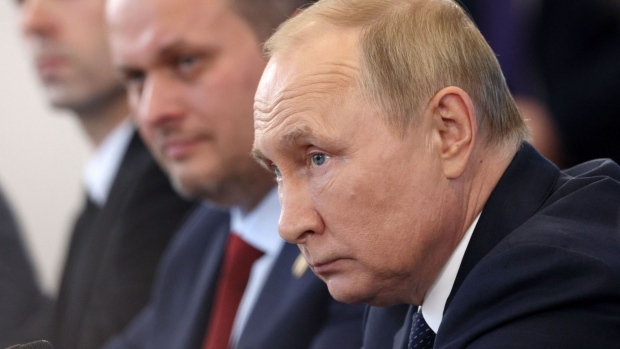Sep 23, 2022
Putin’s Conscripts Won’t Win His War But May Drag It Out
, Bloomberg News

(Bloomberg) -- Russian President Vladimir Putin’s move to draft in 300,000 reservists to reinforce his troops in Ukraine is likely to extend the war rather than influence its outcome.
Still, it could buy him time to execute a wider strategy -- including exacerbating Europe’s energy crisis and threatening a nuclear strike on unspecified targets -- aimed at undermining foreign military and financial support for Kyiv’s war effort.
Everything about Putin’s decision to order a partial mobilization is surrounded by questions, including the feasibility of the number itself. Other unknowns include the speed, quality and goals of a mass training exercise that’s about to begin.
But basic math suggests the phased recruitment program will prove to be more about rebuilding capability and rotating exhausted combat troops, than providing a fresh force capable of throwing Ukraine back onto the defensive, say military analysts from Washington to Moscow.
Not only has Russia lost about 80,000 soldiers dead or wounded in Ukraine, according to estimates by Kyiv’s allies, but with insufficient manpower for rotation many troops are now spending their eighth month in the field.
“I’m not sure this amounts to an escalation, but it does extend the time it will take for Ukraine to win,” said Igor Levchenko, head of strategic modeling at New Geopolitics, a Kyiv based think tank. And that could be significant.
One of Russia’s few strategic successes has been to slow the supply of weapons from the US and other allies to Ukraine by threatening escalation, with delivery of each arms system -- from Javelin anti-tank missiles to HIMARS multiple launch rocket systems -- delayed by fears its transfer might provoke a Russian response, according to Levchenko.
Armed with the long range ATACMS rockets the US has balked at supplying, along with aircraft and Abrams tanks, Ukraine could recover its lost territory in weeks, according to Levchenko. Those weapons are being withheld as “a direct result of the strategic thinking of Russia’s politicians and military,” he said, adding that Putin’s recent nuclear threat risks extending hesitation in Washington. “That is a very bad story for Ukraine.”
The US continues to focus on open and clear talks with Ukraine and its other allies on its needs, including more medium and long-term weapons requirements, according to Pentagon spokesman Brigadier General Patrick Ryder. “I don’t see those conversations being impacted by this situation,” he said, referring to recent steps by Russia including sham votes starting Friday in territory it holds in Ukraine on annexation.
The US will look “at a variety of capabilities in the days ahead,” he added, in response to a question on whether America could yet send Abrams tanks.
For now there’s been no shift in position among Ukraine’s allies or their support for Kyiv’s counteroffensive, according to a European official, who asked not to be identified, although they indicated that could change.
Military analysts and officials outside Ukraine also expressed skepticism at the capacity of Russia’s partial mobilization to transform the war’s trajectory on the ground.
Russian military planners will face a dilemma of either putting very low quality forces raised from the draft into the field, or spending time training a higher quality force, Western officials said in a briefing. They also predicted the new units would be poorly equipped.
“300,000 additional troops is not enough for Russia to make advances in Ukraine,” said Pavel Zolotarev, a retired Russian general who’s now an analyst at the Institute for U.S. and Canadian Studies in Moscow. “This is just enough to stop the Ukrainian offensive and cement control over territories that Russian forces control now.”
The partial mobilization “is unlikely to generate effective soldiers” or block Ukraine’s opportunities for retaking territory through the winter, the Institute for the Study of War, a US think tank that tracks the conflict in daily reports, concluded in its latest assessments.
Ukraine’s offensive continues to make progress, but has slowed since the runaway successes earlier this month in the north eastern Kharkiv region.
Mark Hertling, a former Commanding General of US Army Europe, pointed to limited Russian capacity and severe weaknesses in basic training methods he had seen on visits to the Russian military.
“It was awful,” Hertling wrote in a Twitter thread. “Familiarization versus qualification on rifles, rudimentary first aid, very few simulations to conserve resources, and...most importantly...horrible leadership by ‘drill sergeants’.”
Michael Kofman, a specialist in Russia’s military at the CNA security think tank in Washington, said in a podcast the 300,000 target was likely “notional.” Russian commanders, he said, would have mainly poor options deciding to do with the new draftees.
One would be to replenish existing Russian Battle Tactical Groups in Ukraine, many of which are staffed at 40%-50% of their intended strength, according to Kofman. But most Russian training takes place within units, taking away scarce and exhausted officers to do the job.
Another route would be to build large, lightly armed and motorized units to simply hold the line in defensive positions. A third would be to create capable units, able to rotate exhausted troops along the front, but that would require significant time and investment to bring them to the required level.
“The implications of this are that Russia can try to stem the deteriorating situation in their military and try to address the quantity aspect of the force,” he said. “But they can’t fix the quality because they have already used up their best equipment, their best officers, their best munitions and the issue of morale is going to be a perpetual one.”
(Updates with comments from Western officials)
©2022 Bloomberg L.P.


